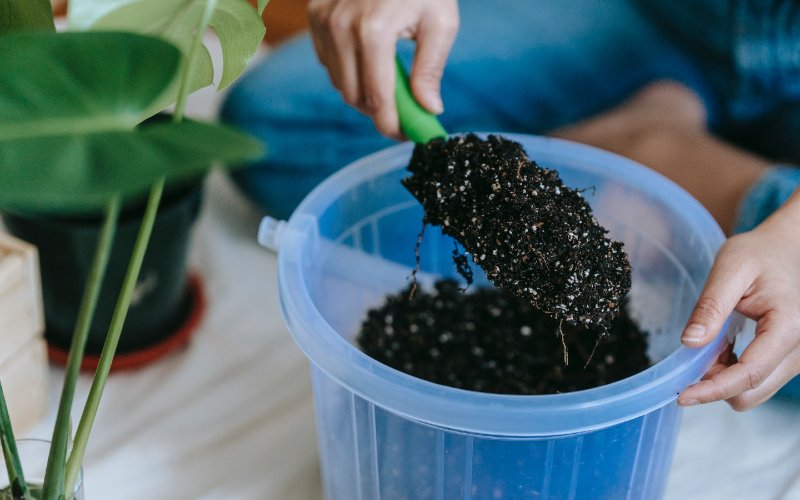How to Plant Aloe Plants Without Roots: 5 Simple Steps
-
Ashley Bates
- Last updated:

Aloe plants are one of the most popular succulents people have in their homes. From their funky, heavy stalks to their medicinal properties, these plants are as useful as they are interesting to look at!
Aloe plants are also extremely easy to grow, even without roots. Like other succulents, these plants can regenerate from a stalk alone. Let’s explain how to create successful fresh aloe plants without roots!
How to Plant Aloe Plants Without Roots: 5 Steps
1. Water, Water, Water!
Before taking a leaf cutting from your aloe plant, you need to make sure the plant is fully hydrated. You will want the leaves to be as full as possible, without overwatering.
So, a day or two before you take the actual cutting from the mother plant, thoroughly water the soil, making sure that it is entirely saturated. For this step, we will only work with aloe plants that have very well-draining soil so that moisture doesn’t become trapped, unable to get out.

2. Take Your Cut
Next, it’s time to remove the leaf-cutting from the plant. Find the leaf that is most suitable before making your cut. You need to ensure that you select a tool that has been completely sanitized to avoid damage or disease to your aloe plant.
Breaking a leaf away from the plant can make way for disease, infestations, and infection. We recommend taking your pruners or knife and rubbing isopropyl alcohol onto the blade.
Take a cotton swab, cotton ball, or clean cloth, dip it in the alcohol, and carefully wipe every blade. The alcohol will quickly evaporate and destroy existing bacteria, viruses, and fungi that might be on the surface.
Once your tool is completely sanitized and dry, you can cut the leaf stem where it is attached to the plant.
3. Let the Cutting Callus
Much like a scab on our skin, the cut portion of the plant will begin to dry and callous over. Now, the cutting will need time to callous over before continuing. These calluses prevent the transmission of disease or the infestation of insects from affecting the tissue inside.
If you place the cut leaf on a paper towel or cloth, the cutting will naturally callus over to create a seal. To prevent damage, you should ensure that the cutting is out of direct sunlight. The process of completely creating a callous generally takes 3 to 5 days.

4. Prep the New Pot
Next, you will need to find a suitable pot for early growth. The soil you choose needs to nourish the type of plant you’re growing. For aloe, like many succulents, it requires a well-draining potting soil designed for these plants.
The soil should include materials like perlite, bark, lava rock, and other organic materials.
5. Plant It in Soil
You can stick the plant in the soil upright. Lightly water, but make sure not to saturate the soil over, as it can cause the new plant to rot. After several weeks, the cutting will produce new roots to establish the plant.

Other Ways to Plant Aloe
You don’t have to take cuts from your aloe plant to produce new plants. Here are a few other options.
If your aloe plant has pups, you can turn them into self-sufficient plants—even if they don’t have roots.
The quickest and most effective way to grow an aloe plant without roots is through stem clipping. To propagate these plans, you can take a leaf cutting from the aloe plant and follow a few small steps to achieve results.
Remove Aloe Pups from Parent Plant
You might have looked in on your beautifully growing aloe plant to realize they’ve had babies! If you see small aloe pups, you can remove them from the planter and put them on their own.
This is questionably the easiest way to grow aloe plants, as a new shoot is already prepared for you. You simply take a sharp knife and cut around the aloe pup roughly one inch deep and gently remove it from the container.
After replanting, roots should form and have the strength to stabilize the pup. This new sprout will likely thrive just fine on its own.

Turn a Broken Leaf into a New Plant
Our plants can break off quite easily. If this happens, you can take it as an opportunity to grow an entirely new plant. It might be a little tricky and sometimes not as fruitful as you would wish, but it’s always worth a try.
Before you do any planting, you need to sterilize the broken edge with a sharp, adequately cleaned knife. This way, the leaf can repair itself. This is very similar to how we guided you in the beginning of the article—but this method may not be successful if the leaf is damaged.
So, if the plant breaks, follow the same steps, but ensure to sterilize the edges of the broken leaf both on the plant and the broken piece.
Conclusion
Now you know that you can easily create an entire new aloe plant just from one rootless cutting of your aloe mother plant. Permitting you make the correct cuts using proper sterilization methods, your new cut should take off with its own roots in just a few weeks!
Featured Image Credit: Sunny_Smile, Shutterstock
Contents
